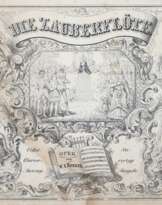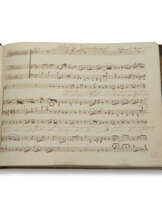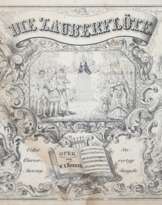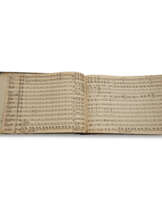ID 1109003
Lot 203 | [Wolfgang Amadeus Mozart (1756-1791)] – Thomas Attwood (1765-1838)
Estimate value
£ 10 000 – 15 000
Autograph manuscript account by Attwood of his time spent with Mozart in Vienna in June 1785, n.d. [?1820s]
Two pages, 230 x 190mm, watermark of 'E Barnard improved superfine'; [with] an album leaf comprising, laid down, an autograph letter signed by Attwood, 23 August 1836, and a note and admission ticket addressed to him by 'Mr Macready'. Provenance: Sotheby's, 12 May 1981, lot 161.
An eye-witness description of Mozart by his English pupil, Thomas Attwood. Attwood gives a vivid pen-portrait of Mozart's physical appearance, his compositional practice, his teaching methods, the first performances of Figaro, his love of the music of J.S. Bach, his performing practice, and a memory of him playing the D minor piano concerto (K. 466), the concert aria 'Non temer, amato bene' (K. 490) and 'Deh vieni' from Figaro at a benefit concert for the English soprano Nancy Storace. He ends with a note of the contrasting payments given to Mozart and Martini by the Emperor, and about the publication of the 'Haydn quartets' of 1785.
Mozart at the time I was with him, appeared to be of a cheerful habit, his health not very strong. In consequence of leaning so much over the table when composing, he was obliged to have an upright Desk, & stand, when he wrote – His Eyes were dark Blue very prominent & expressive, The first time I played to him I can never forget (naturally alarmed) his Eyes seemed to pierce me through – He was however very indulgent at the time & gave me some Music to practice, which when I opened proved to be the Scales ! in all the Major & Minor Modes! – ... [I] attempted attempted two Quartetts for Two V[iolins], viola & violoncello – which Mozart corrected, & after they were gone, He said, "you seem to like composition therefore we will begin again" – ... Mozart always wrote his rules for Composition, step by step – in Canto firmo he was very particular – In correcting my scores he wrote the passage on a seperate [sic] sheet – His Symphonies & Concertos, were composed chiefly for his concerts of which he Had two in the year, he also played an extemporanious piece from an [sic] subject given him – He was so fond of Sebastian Bach's Preludes & Fugues, that he had a seperate Pianoforte with Pedals, fixed under the Other – ... The last time I heard him, He play'd his Concerto in D Minor, & "Non temere" at Storace's Benefit for whom he composed that Cantata with the Pianoforte, solo – The taste of the time was not accostomed [sic] to the rich Harmonies of Mozart when he wrote Figaro, & the Singers complained that they were overwhelmed with the wind Instruments, he therefore (to please Storace) wrote "Deh viene, Joia bella" with so delicate an accompaniment –'.
Thomas Attwood (1765-1838) was sent to study abroad at the expense of the future George IV in 1783, initially in Naples with Felipe Cinque and Gaetano Latilla, and then from August 1785 to 1787 with Mozart in Vienna. The Irish tenor Michael Kelly recorded Mozart as saying 'Attwood is a young man for whom I have a sincere affection and esteem; ... he partakes more of my style than any scholar I ever had; and I predict that he will prove a sound musician'. Attwood's harmony and counterpart exercises survive with Mozart's model examples and corrections. The English soprano Nancy Storace (1765-1817) was the original Susanna in Figaro: Attwood travelled back to London from Vienna with Storace, her brother, and Michael Kelly. Partially transcribed, with some misreadings, in Cliff Eisen. New Mozart Documents: A Supplement to O.E.Deutsch’s Documentary Biography (1991), no. 64.
| Artist: | Wolfgang Amadeus Mozart (1756 - 1791) |
|---|---|
| Place of origin: | Austria, England, United Kingdom |
| Artist: | Wolfgang Amadeus Mozart (1756 - 1791) |
|---|---|
| Place of origin: | Austria, England, United Kingdom |
| Address of auction |
CHRISTIE'S 8 King Street, St. James's SW1Y 6QT London United Kingdom | |||||
|---|---|---|---|---|---|---|
| Preview |
| |||||
| Phone | +44 (0)20 7839 9060 | |||||
| Buyer Premium | see on Website | |||||
| Conditions of purchase | Conditions of purchase |
![[Wolfgang Amadeus Mozart (1756-1791)] – Thomas Attwood (1765-1838) - photo 1 [Wolfgang Amadeus Mozart (1756-1791)] – Thomas Attwood (1765-1838) - photo 1](/assets/image/picture_3620327/5b30d/83326a0548268312f6e828e1f8c2ff0c1701428400jpg__fix_555_460.jpeg)
![[Wolfgang Amadeus Mozart (1756-1791)] – Thomas Attwood (1765-1838) - photo 2 [Wolfgang Amadeus Mozart (1756-1791)] – Thomas Attwood (1765-1838) - photo 2](/assets/image/picture_3620329/05b94/2094773244cdf08d1e782fb6777bc1811701428400jpg__fix_555_460.jpeg)
![[Wolfgang Amadeus Mozart (1756-1791)] – Thomas Attwood (1765-1838) - photo 3 [Wolfgang Amadeus Mozart (1756-1791)] – Thomas Attwood (1765-1838) - photo 3](/assets/image/picture_3620331/da126/275ca3998f6fe2ba691d2e8d2edc714b1701428400jpg__fix_555_460.jpeg)









![[Wolfgang Amadeus Mozart (1756-1791)] – Thomas Attwood (1765-1838) - photo 1 [Wolfgang Amadeus Mozart (1756-1791)] – Thomas Attwood (1765-1838) - photo 1](/cache/lot/1109003/83326a0548268312f6e828e1f8c2ff0c_1701428400-80x80_center_50.jpg)
